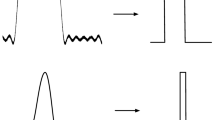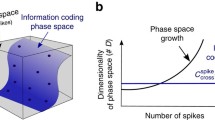Abstract
This paper surveys recent findings in neuroscience regarding the behavioral relevancy of the precise timing with which real spiking neurons emit spikes. The literature suggests that in almost any system where the processing-speed of a neural (sub)-system is required to be high, the timing of single spikes can be very precise and reliable. Additionally, new, more refined methods are finding precisely timed spikes where previously none where found. This line of evidence thus provides additional motivation for researching the computational properties of networks of artificial spiking neurons that compute with more precisely timed spikes.
Similar content being viewed by others
References
AgmonSnir H, Carr C and Rinzel J (1998) The role of dendrites in auditory coincidence detection. Nature 393: 268–272
Bair W and Koch C (1996) Temporal precision of spike trains in extrastriate cortex of the behaving macaque monkey. Neural Computation 8(6): 1185–1202
Beierholm U, Nielsen C, Ryge J, Alstrom P and Kiehn O (2001) Characterization of reliability of spike timing in spinal interneurons during oscillating inputs. J. Neurophysiol. 86: 1858–1868
Bell C, Han V, Sugawara Y and Grant K (1997) Synaptic plasticity in a cerebellum-like structure depends on temporal order. Nature 387: 278–281
Bi B-q and Poo M-m (1999) Distributed synaptic modification in neural networks induced by patterned stimulation. Nature 401: 792–716
Bi G-q and Poo M-m (1998) Synaptic modifications in cultured hippocampal neurons: Dependence on spike timing, synaptic strength, and postsynaptic cell type. J. Neurosci. 18(24): 10464–10472
Bi G-q and Poo M-m (2001) Synaptic modification by correlated activity: Hebb's postulate revisited. Annu. Rev. Neurosci. 24: 139–166
Bialek W, Rieke F, Steveninck R de Ruyter van and Warland D (1991) Reading a neural code. Science 252: 1854–1857
Bohte SM, Kok JN and La Poutré H (2002a) Spike-prop: error-backpropagation in multi-layer networks of spiking neurons. Neurocomputing 48(1–4): 17–37
Bohte SM, Kok JN and La Poutré H (2002b) Unsupervised classification in a layered RBF network of spiking neurons. IEEE Trans. Neural Networks: 426–435
Brenner N, Strong SP, Koberle R, Bialek W and de Ruyter van Steveninck RR (2000) Synergy in a neural code. Neural Computation 12(7): 1531–1552
Buracas G, Zador A, DeWeese M and Albright T (1998) Efficient discrimination of temporal patterns by motion-sensitive neurons in primate visual cortex. Neuron 20: 959–969
Carr C and Konishi M (1990) A circuit for detection of interaural time differences in the brain stem of the barn owl. J. Neurosci. 10: 3227–3246
Chechik G (2003) Spike-timing-dependent-plasticity and relevant mutual information maximization. Neural Computation 15: 1481–1510
Dayan P, Hausser M and London M (2003) Plasticity kernels and temporal statistics. In: Nips 2002 (Vol. 15). The MIT Press (to appear)
de Ruyter van Steveninck R, Borst A and Bialek W (2001) Real-time encoding of motion: answerable questions and questionable answers from the fly's visual system. In: Zanker J and Zeil J (eds) Motion Vision — Computational, Neural, and Ecological Constraints. Springer Verlag, Berlin Heidelberg New York
de Ryter van Steveninck R, Lewen G, Strong S, Koberle R and Bialek W (1997) Reproducibility and variability in neural spike trains. Science 275: 1805–1808
deCharms R and Merzenich M (1996) Primary cortical representation of sounds by the coordination of action-potential timing. Nature 381: 610–613
Delorme A, Gautrais J, VanRullen R and Thorpe S (1999) Spikenet: A simulator for modeling large networks of integrate and fire neurons. Neurocomputing: 989–996
DeWeese M and Zador A (2002) Binary coding in auditory cortex. In: Advances in Neural Information Processing Systems (Vol. 15). The MIT Press
Eisele M and Miller K (2003) Hidden markov model of cortical synaptic plasticity: Derivation of the learning rule. In: Nips 2002 (Vol. 15). The MIT Press (to appear)
Fairhall A, Lewen G, Bialek W and de Ruyter van Steveninck R (2001) Efficiency and ambiguity in an adaptive neural code. Nature 412: 787–792
Feldman D, Nicoll R, Malenka R and Isaac J (1998) Long-term depression at thalamocortical synapses in developing somatosensory cortex. Neuron 21: 347–357
Fellous J-M, Houweling A, Modi R, Rao R, Tiesinga P and Sejnowski T (2001) Frequency dependence of spike timing reliability in cortical pyramidal cells and interneurons. J. Neurophysiol. 85: 1782–1787
Gerstner W (1998) Spiking neurons. In: Maass W and Bishop CM (eds) Pulsed Neural Networks, pp. 3–55. The MIT Press.
Gerstner W (2000) Population dynamics of spiking neurons: Fast transients, asynchronous states, and locking. Neural Computation 12(1): 43–89
Gerstner W, Kempter R, Hemmen J van and Wagner H (1996) A neuronal learning rule for sub-millisecond temporal coding. Nature 383: 76–78
Gray C (1999) The temporal correlation hypothesis of visual feature integration: Still alive and well. Neuron 24: 31–47
Gray C, König P, Engel A and Singer W (1989) Oscillatory responses in cat visual cortex exhibit inter-columnar synchronization which reflects global stimulus properties. Nature 338: 334–337
Harris K, Henze D, Hirase H, Leinekugel X, Dragoi G, Czurkó A and Buzsáki (2002) Spike train dynamics predicts theta-related phase precession in hippocampel pyramidal cells. Nature 417: 738–741
Heiligenberg W (1991) Neural Nets in Electric Fish. MIT Press.
Hopfield J (1995) Pattern recognition computation using action potential timing for stimulus representation. Nature 376: 33–36
Hopfield J and Brody C (2000) What is a moment? transient synchrony as a collective mechanism for spatiotemporal integration. Proc. Natl. Acad. Sci. USA 97: 13919–13924
Izhikevich E, Deai N, Walcott E and Hoppensteadt F (2003) Bursts as a unit of neural information: selective communication via resonance. Trends Neurosci. 26(3): 161–167
Johansson R and Birznieks I (2004) Fist spikes in ensembles of human tactile afferents code complex spatial fingertip events. Nature Neurosci. 7(2): 170–177
Kandel E, Schwartz J and Jessell T (eds) (1991) Principles of Neural Science (third ed.). Elsevier/North-Holland, Amsterdam, London, New York
Kepecs A, van Rossum M, Song S and Tegner J (2002) Spike-timing plasticity: common themes and divergent vistas. Biol. Cybern. 87: 446–458
Kuwabara N and Suga N (1993) Delay lines and amplitude selectivity are created in subthalamic auditory nuclei: the branchium of the inferior colliculus of the mustached bat. J. Neurophysiol. 69: 1713–1724
Laurent G (1999) A systems perspective on early olfactory coding. Science 286: 723–728
Laurent G, Wehr M and Davidowitz H (1996) Temporal representations of odors in an olfactory network. J. Neurosci. 16(12): 3837–3847
Lewen G, Bialek W. and de Ruyter van Steveninck R (2001) Neural coding of naturalistic motion stimuli. Network: Comput. Neural Syst. 12: 317–329
Liu R, Tzonev S, Rebrik S and Miller K (1997) The structure and precision of retinal spike trains. Proc. Nat. Acad. Sc. USA 94: 5411–5416
Liu R, Tzonev S, Rebrik S and Miller K (2001) Variability and information in a neural code of the cat lateral geniculate nucleus. J. Neurophys. 86: 2789–2806
Maass W (1997a) Fast sigmoidal networks via spiking neurons. Neural Computation 9(2): 275–304
Maass W (1997b) Networks of spiking neurons: The third generation of neural network models. Neural Networks 10(9): 1659–1671
Mainen Z and Sejnowski T (1995) Reliability of spike timing in neocortical neurons. Science 268(5216): 1503–1506
Markram H, Lübke J, Frotscher M and Sakmann B (1997) Regulation of synaptic efficacy by coincidence of postsynaptic aps and epsps. Nature 375: 213–215
Mehta M, Lee A and Wilson M (2002) Role of experience and oscillations in transforming a rate code into a temporal code. Nature 417: 741–746
O'Keefe J and Recce M (1993) Phase relationship between hippocampal place units and the EEG theta rhythm. Hippocampus 3: 317–330
Oram M, Xiao D, Dritschel B and Payne K (2002) The temporal resolution of neural codes: does response latency have a unique role? Phil. Trans. R. Soc. Lond. B 357: 987–1001
Reich D, Mechler F and Victor J (2001) Independent and redundant information in nearby cortical neurons. Science 294: 2566–2568
Reinagel P and Reid R (2000) Temporal coding of visual information in the thalamus. J. Neurosci. 20(14): 5392–5400
Shadlen M. and Movshon J (1999) Synchrony unbound: A critical evaluation of the temporal binding hypothesis. Neuron 24: 67–77
Shadlen M and Newsome W (1994) Noise, neural codes and cortical organization. Curr. Opin. Neurobiol. 4: 569–579
Shadlen M and Newsome W (1995) Is there a signal in the noise? Curr. Opin. Neurobiol. 5: 248–250
Shadlen M and Newsome W (1998) The variable discharge of cortical neurons: implications for connectivity, computation and information coding. J. Neuronsci 18: 3870–3896
Singer W (1999) Neuronal synchrony: A versatile code for the definition of relations. Neuron 24: 49–65
Softky W (1995) Simple codes versus efficient codes. Curr. Opin. Neurobiol. 5: 239–247
Softky W and Koch C (1993) The highly irregular firing of cortical cells is inconsistent with temporal integration of random epsp's. J. Neurosci. 13: 334–350
Stopfer M and Laurent G (1999) Short-term memory in olfactory network dynamics. Nature 402: 610–614
Stratford K, Tarczy-Hornoch K, Martin K, Bannister N and Jack J (1996) Excitatory synaptic inputs to spiny stellate cells in cat visual cortex. Nature 382: 258–261
Thorpe S, Fize F and Marlot C (1996) Speed of processing in the human visual system. Nature 381: 520–522
von der Malsburg C (1981) The correlation theory of brain function. Internal Report 81-2, Max-Planck-Institute for Biophysical Chemistry, Göttingen, Germany
Williams S and Stuart G (2002) Dependence of epsp efficacy on synapse location in neocortical pyramidal neurons. Science 295: 1907–1910
Zhang L, Tao H, Holt C, Harris W, Poo M (1998) A critical window for cooperation and competition among developing retinotectal synapses. Nature 395(3): 37–44
Author information
Authors and Affiliations
Rights and permissions
About this article
Cite this article
Bohte, S.M. The evidence for neural information processing with precise spike-times: A survey. Natural Computing 3, 195–206 (2004). https://doi.org/10.1023/B:NACO.0000027755.02868.60
Issue Date:
DOI: https://doi.org/10.1023/B:NACO.0000027755.02868.60




